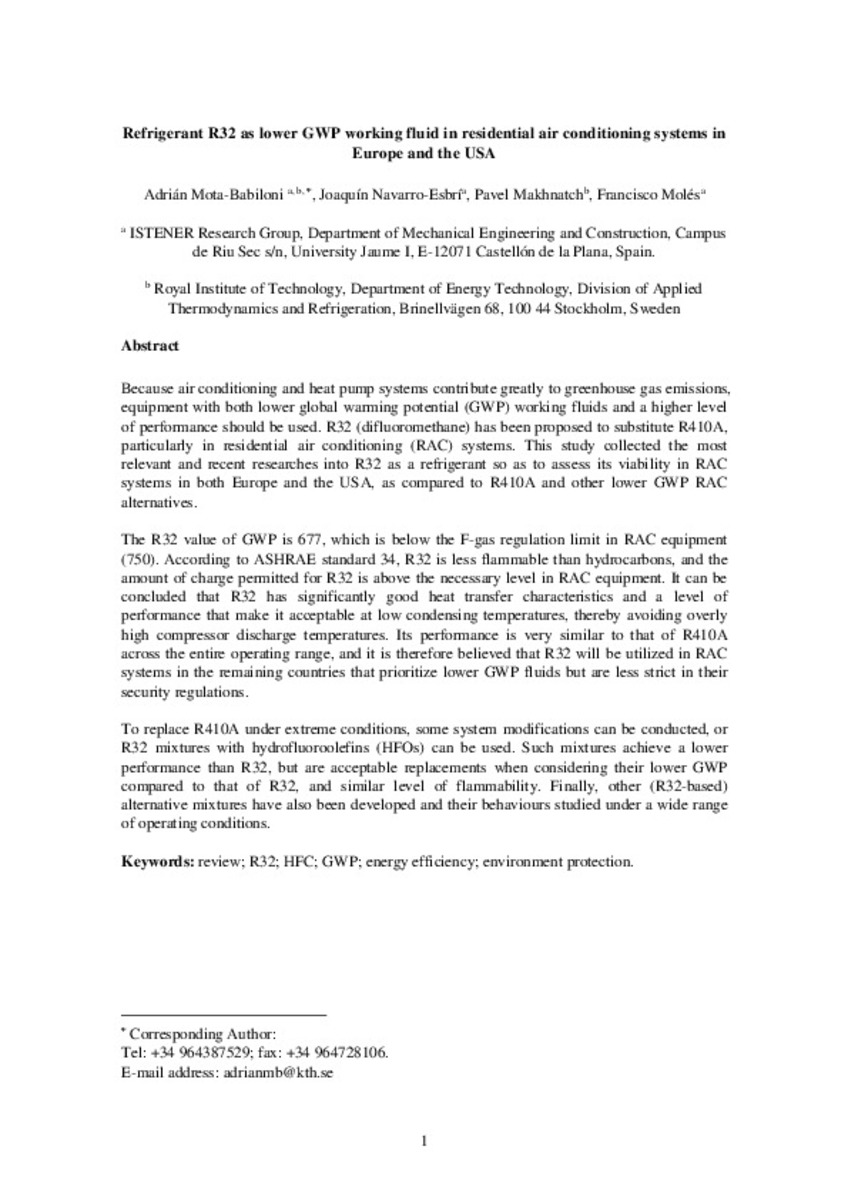Mostrar el registro sencillo del ítem
Refrigerant R32 as lower GWP working fluid in residential air conditioning systems in Europe and the USA
| dc.contributor.author | Mota-Babiloni, Adrián | |
| dc.contributor.author | Navarro-Esbrí, Joaquín | |
| dc.contributor.author | Makhnatch, Pavel | |
| dc.contributor.author | Moles, Fran | |
| dc.date.accessioned | 2017-11-22T15:08:04Z | |
| dc.date.available | 2017-11-22T15:08:04Z | |
| dc.date.issued | 2017 | |
| dc.identifier.citation | Mota-Babiloni, A., Navarro-Esbrí, J., Makhnatch, P., & Molés, F. (2017). Refrigerant R32 as lower GWP working fluid in residential air conditioning systems in Europe and the USA. Renewable and Sustainable Energy Reviews, 80, 1031-1042 | ca_CA |
| dc.identifier.issn | 1364-0321 | |
| dc.identifier.uri | http://hdl.handle.net/10234/170305 | |
| dc.description.abstract | Because air conditioning and heat pump systems contribute greatly to greenhouse gas emissions, equipment with both lower global warming potential (GWP) working fluids and a higher level of performance should be used. R32 (difluoromethane) has been proposed to substitute R410A, particularly in residential air conditioning (RAC) systems. This study collected the most relevant and recent researches into R32 as a refrigerant so as to assess its viability in RAC systems in both Europe and the USA, as compared to R410A and other lower GWP RAC alternatives. The R32 value of GWP is 677, which is below the F-gas regulation limit in RAC equipment (750). According to ASHRAE standard 34, R32 is less flammable than hydrocarbons, and the amount of charge permitted for R32 is above the necessary level in RAC equipment. It can be concluded that R32 has significantly good heat transfer characteristics and a level of performance that make it acceptable at low condensing temperatures, thereby avoiding overly high compressor discharge temperatures. Its performance is very similar to that of R410A across the entire operating range, and it is therefore believed that R32 will be utilized in RAC systems in the remaining countries that prioritize lower GWP fluids but are less strict in their security regulations. To replace R410A under extreme conditions, some system modifications can be conducted, or R32 mixtures with hydrofluoroolefins (HFOs) can be used. Such mixtures achieve a lower performance than R32, but are acceptable replacements when considering their lower GWP compared to that of R32, and similar level of flammability. Finally, other (R32-based) alternative mixtures have also been developed and their behaviours studied under a wide range of operating conditions. | ca_CA |
| dc.description.sponsorShip | The authors thankfully acknowledge the Spanish Ministry of Education, Culture, and Sport for supporting this work through “Becas y Contratos de Formación de Profesorado Universitario del Programa Nacional de Formación de Recursos Humanos de Investigación del ejercicio 2012 (Grant number FPU12/02841)” and “Ayudas complementarias para beneficiarios de ayudas (FPU): Estancias Breves. Convocatoria 2015 (Grant number EST15/00154)”. The authors are also grateful to the Swedish Energy Agency for supporting this study under the “EFFSYS EXPAND P08” research program. | |
| dc.format.extent | 35 p. | ca_CA |
| dc.format.mimetype | application/pdf | ca_CA |
| dc.language.iso | eng | ca_CA |
| dc.publisher | Elsevier | ca_CA |
| dc.relation.isPartOf | Renewable and Sustainable Energy Reviews, 2017, Vol. 80 | |
| dc.rights.uri | http://rightsstatements.org/vocab/CNE/1.0/ | * |
| dc.subject | review | ca_CA |
| dc.subject | R32 | ca_CA |
| dc.subject | HFC | ca_CA |
| dc.subject | GWP | ca_CA |
| dc.subject | energy efficiency | ca_CA |
| dc.subject | environment protection | ca_CA |
| dc.title | Refrigerant R32 as lower GWP working fluid in residential air conditioning systems in Europe and the USA | ca_CA |
| dc.type | info:eu-repo/semantics/article | ca_CA |
| dc.identifier.doi | https://doi.org/10.1016/j.rser.2017.05.216 | |
| dc.rights.accessRights | info:eu-repo/semantics/openAccess | ca_CA |
| dc.relation.publisherVersion | http://www.sciencedirect.com/science/article/pii/S1364032117308559 | ca_CA |
| dc.type.version | info:eu-repo/semantics/submittedVersion | ca_CA |
Ficheros en el ítem
Este ítem aparece en la(s) siguiente(s) colección(ones)
-
EMC_Articles [806]







